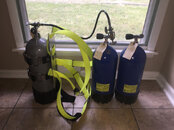My question is that I don’t want to leave my tanks empty to long after an inspection and getting them filled right away isn’t always an option. My idea is to use what I believe to be called a whip and add air from a full tank to a empty tank. Has it does anyone currently do this?
Absolutely! Personally, I consider a tank equalizing whip to be an (almost-) essential part of your diving gear--right up there with your save-a-dive kit. It has many uses. For example, are you and your buddy diving similar tanks, and about to do a recreational repetitive dive? Then if you equalize your tank with your buddy's, dive planning for that repetitive dive is made so much simpler.
I purchased my very simple, inexpensive, equalizing whip many, many years ago (maybe 1994) from Northeast, iirc. If I were to purchase one now, I would choose to have DIN ends (instead of A-clamp ends), and I would add a pressure gauge (for maximum flexibility).
Gotta go. I took the day off. So, of course, I'm playing with scuba gear. I'm about to change out the K-valve on my steel 72 for a Y-valve (for winter diving). This means eventually using my equalizing whip for putting some air back into the 72 once the Y-valve is in place.
rx7diver




